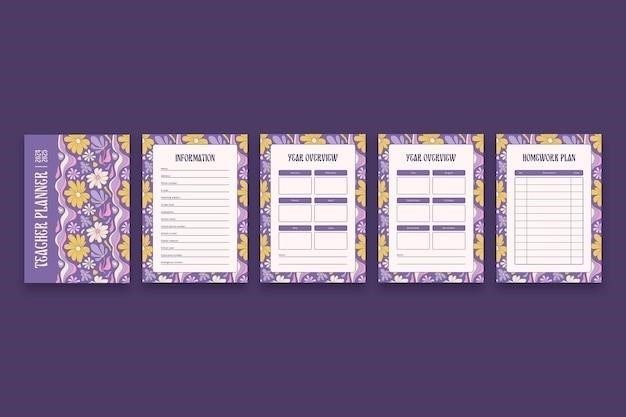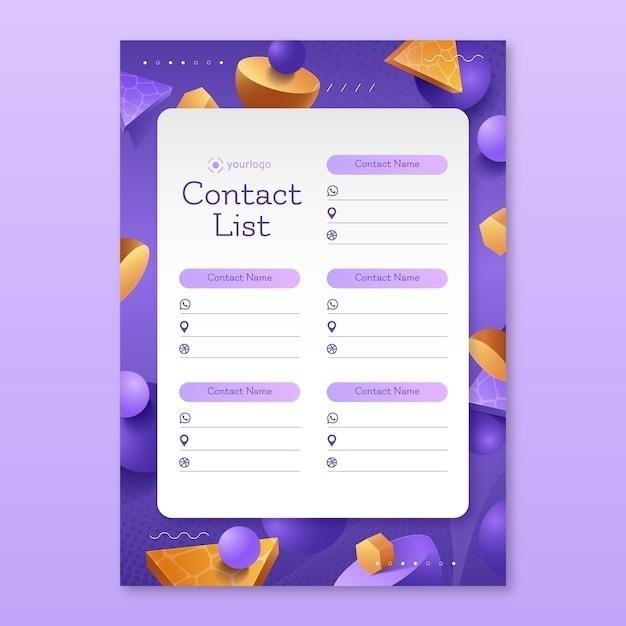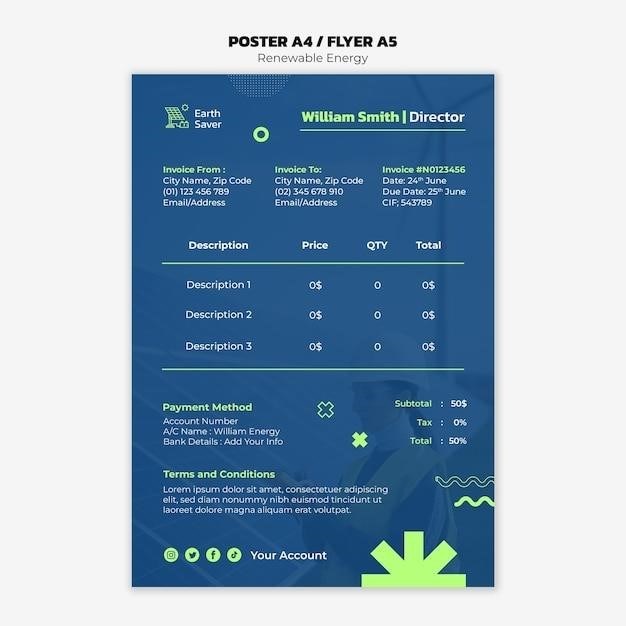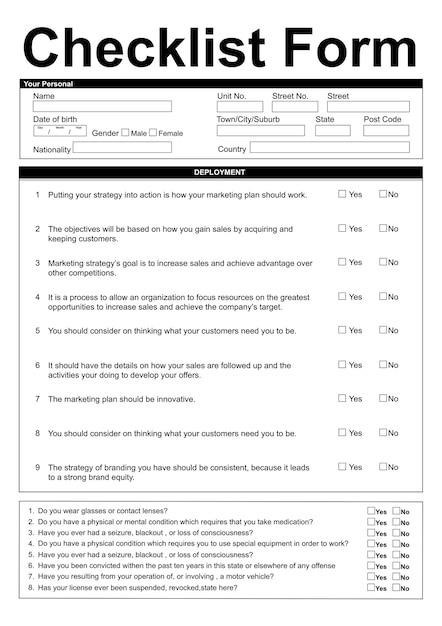Weathering⁚ A Comprehensive Worksheet
This worksheet provides a detailed exploration of weathering, a fundamental geological process that shapes Earth’s surface. Explore the various types of weathering, factors influencing it, and its impact on the environment.
Introduction to Weathering
Weathering is a fundamental geological process that involves the breakdown of rocks, soils, and minerals through direct contact with the Earth’s atmosphere, water, and biological organisms. It is a slow and continuous process that occurs over vast periods, shaping Earth’s landscapes and influencing the formation of soils, sediments, and landforms. Weathering is crucial for the cycling of nutrients, the creation of fertile soils, and the development of unique geological features.
The process of weathering can be broadly categorized into three main types⁚ physical weathering, chemical weathering, and biological weathering. These types often work together in a complex interplay, each contributing to the breakdown of Earth materials.
Understanding weathering is essential for geologists, soil scientists, and environmental scientists. It helps us comprehend the formation and evolution of landscapes, the dynamics of soil development, and the potential impacts of human activities on the environment. By exploring the various aspects of weathering, we gain insights into the intricate processes that shape our planet and the delicate balance within Earth’s systems.
Types of Weathering
Weathering, the breakdown of rocks and minerals, occurs through various processes that can be categorized into three primary types⁚ physical, chemical, and biological weathering. Each type plays a distinct role in shaping Earth’s surface.
Physical weathering, also known as mechanical weathering, involves the disintegration of rocks into smaller fragments without altering their chemical composition. This process is primarily driven by forces like temperature changes, frost wedging, and abrasion by wind, water, or ice. Physical weathering weakens rocks and creates more surface area for further weathering.
Chemical weathering, on the other hand, involves the alteration of the chemical composition of rocks and minerals. This process is driven by reactions with water, oxygen, and other chemicals, leading to the formation of new minerals or the dissolution of existing ones. Chemical weathering weakens rocks and can create new minerals that are more susceptible to further weathering.
Biological weathering, as its name suggests, involves the breakdown of rocks and minerals through the actions of living organisms. This includes the growth of plant roots, the burrowing of animals, and the activities of microorganisms. Biological weathering often enhances the effects of physical and chemical weathering, creating a complex interplay of processes.
2.1. Physical Weathering
Physical weathering, also known as mechanical weathering, involves the disintegration of rocks into smaller fragments without altering their chemical composition. This process is primarily driven by forces like temperature changes, frost wedging, and abrasion by wind, water, or ice. Physical weathering weakens rocks and creates more surface area for further weathering.
Temperature changes, particularly the repeated expansion and contraction of rocks due to heating and cooling, can cause stress that eventually leads to fracturing. This process, known as thermal stress weathering, is particularly effective in areas with large temperature fluctuations.
Frost wedging occurs when water seeps into cracks in rocks, freezes, and expands. The expansion exerts pressure on the rock, widening the cracks and eventually breaking the rock apart. This process is common in regions with frequent freeze-thaw cycles.
Abrasion, the wearing away of rocks by the grinding action of other particles, is a significant force in physical weathering. Wind-blown sand, glacial ice, and flowing water can all act as agents of abrasion.
2.2. Chemical Weathering
Chemical weathering involves the breakdown of rocks through chemical reactions that alter their mineral composition. Unlike physical weathering, which only changes the size and shape of rocks, chemical weathering transforms the rocks themselves.
One common type of chemical weathering is dissolution, where minerals in rocks dissolve in water. This process is especially effective in areas with acidic rainwater, which can dissolve minerals like calcite, a major component of limestone.
Oxidation, the reaction of minerals with oxygen, is another important chemical weathering process. When iron in rocks is exposed to oxygen, it forms iron oxide, which is commonly known as rust. This process weakens the rock and gives it a reddish-brown color.
Hydrolysis, the reaction of minerals with water, can also lead to chemical weathering. This process breaks down minerals, especially feldspars, into clay minerals, which are more stable in the presence of water.
Carbonation, the reaction of carbon dioxide with water to form carbonic acid, is a significant chemical weathering process. Carbonic acid can dissolve carbonates, like limestone, leading to the formation of caves and sinkholes.
2.3. Biological Weathering
Biological weathering involves the breakdown of rocks through the actions of living organisms. These organisms can physically break down rocks or chemically alter them through their metabolic processes.
Plants play a significant role in biological weathering. Their roots can grow into cracks in rocks, exerting pressure that widens the cracks and eventually breaks the rocks apart. The acids produced by plants can also dissolve minerals in rocks, leading to chemical weathering.
Animals contribute to biological weathering by burrowing, digging, and trampling on rocks. For example, earthworms create tunnels that expose rocks to the elements, making them more susceptible to weathering.
Microorganisms, such as bacteria and fungi, can also break down rocks through chemical processes. They produce acids and enzymes that dissolve minerals, contributing to the weathering process.
The activities of lichens, which are symbiotic relationships between algae and fungi, are particularly important in biological weathering. Lichens can grow on rocks and produce acids that dissolve minerals, leading to the formation of a thin layer of soil that can support other organisms.
Factors Influencing Weathering
The rate and extent of weathering are influenced by a variety of factors that interact in complex ways. Understanding these factors is crucial for predicting and managing the effects of weathering on landscapes, infrastructure, and other human activities.
Climate plays a major role in weathering. Temperature variations, precipitation, and humidity all influence the rate and type of weathering. For example, areas with frequent freeze-thaw cycles experience significant physical weathering due to the expansion and contraction of water in rock pores.
The type of rock is another important factor. Some rocks, like granite, are more resistant to weathering than others, like limestone. The composition and structure of rocks determine their susceptibility to different weathering processes.
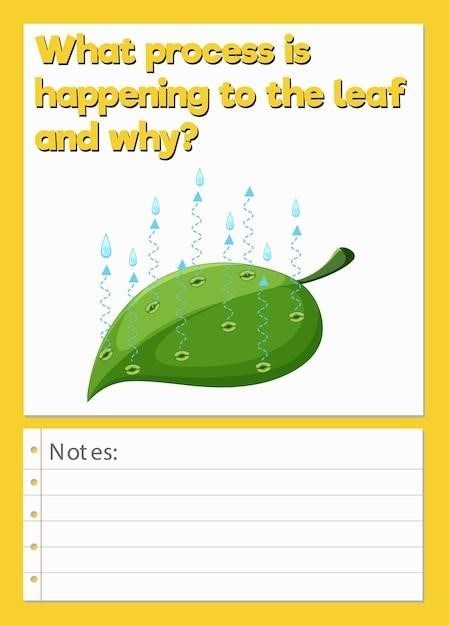
Topography, or the shape and elevation of the land, also influences weathering. Slopes are more exposed to weathering forces, such as wind and rain, than flat areas. Higher elevations experience colder temperatures and greater precipitation, which can accelerate weathering.
In addition to these primary factors, other factors, such as the presence of vegetation, human activities, and the availability of water, can also influence weathering processes.
3.1. Climate
Climate is a dominant factor influencing weathering, as it encompasses various elements that directly impact the breakdown of rocks and minerals. Temperature fluctuations, precipitation patterns, and humidity levels all contribute to the rate and type of weathering processes.
Temperature variations, particularly those involving freezing and thawing, play a crucial role in physical weathering. As water freezes, it expands, exerting pressure on surrounding rocks. This expansion can create cracks and fractures, weakening the rock structure. Repeated freeze-thaw cycles can lead to the disintegration of rocks into smaller fragments.
Precipitation, in the form of rain, snow, or sleet, is another critical factor. Rainfall can dissolve certain minerals, leading to chemical weathering. The amount and intensity of precipitation influence the rate of chemical weathering.
Humidity, or the amount of moisture in the air, also plays a role in weathering. High humidity promotes the growth of lichens and other organisms that contribute to biological weathering.
The combination of these climatic factors determines the overall weathering regime of a region. Areas with high temperature variations and abundant precipitation often experience more intense weathering than areas with stable temperatures and low precipitation.
3.2. Rock Type
The inherent properties of rocks, specifically their composition and structure, significantly influence their susceptibility to weathering. Different rock types possess varying degrees of resistance to weathering processes, leading to diverse landscapes.
Igneous rocks, formed from the cooling and solidification of molten magma or lava, generally exhibit high resistance to weathering. Their crystalline structure and often dense composition make them less prone to breakdown. Granite, a common igneous rock, is renowned for its durability and resistance to weathering.
Sedimentary rocks, formed from the accumulation and cementation of sediments, often display greater vulnerability to weathering. Their layered structure and the presence of various minerals make them susceptible to both physical and chemical weathering.
Metamorphic rocks, formed by the transformation of existing rocks under heat and pressure, can exhibit a wide range of weathering resistance. Their composition and texture vary greatly, depending on the original rock type and the intensity of metamorphic processes.
The mineral composition of rocks also plays a crucial role in their weathering susceptibility. Rocks rich in minerals like calcite, which are readily soluble in acidic solutions, are more susceptible to chemical weathering.
Understanding the characteristics of different rock types is essential for predicting their weathering behavior and its impact on the landscape.
3.3. Topography
Topography, the arrangement of landforms and their elevation, plays a significant role in influencing weathering processes. The shape and orientation of hills, valleys, slopes, and other landforms affect the exposure of rock surfaces to various weathering agents, leading to variations in weathering rates and patterns.
Steep slopes are more susceptible to physical weathering processes like frost wedging and abrasion. The rapid runoff of water on steep slopes can also enhance chemical weathering by facilitating the transport of acidic solutions.
In contrast, gentle slopes tend to experience slower weathering rates due to reduced exposure to physical forces and slower runoff rates. However, they can be prone to soil creep and mass wasting, which can expose underlying rock surfaces to weathering.
The aspect of slopes, their orientation relative to the sun, also influences weathering. South-facing slopes in the Northern Hemisphere receive more direct sunlight, leading to higher temperatures and increased rates of chemical weathering.
The presence of topographic features like valleys and depressions can create microclimates with unique humidity and temperature regimes, further affecting weathering patterns. Valleys often experience higher humidity and slower air movement, promoting chemical weathering processes.
Understanding the relationship between topography and weathering is crucial for analyzing landscape evolution and predicting the impact of weathering on various landforms.
Weathering Processes
Weathering processes are the specific mechanisms by which rocks and minerals break down and decompose. These processes can be physical, chemical, or biological, and they often work in concert to shape the Earth’s surface.
Physical weathering involves the disintegration of rocks into smaller fragments without altering their chemical composition. This can occur through processes like⁚

- Freeze-thaw⁚ The expansion of water as it freezes in cracks and pores within rocks can exert tremendous pressure, leading to the fracturing of rock.
- Abrasion⁚ The grinding and wearing down of rock surfaces by the friction of moving particles like sand, wind, or water.
- Thermal stress⁚ Rapid temperature changes, especially between day and night, can cause the expansion and contraction of rock minerals, leading to stress and eventual fracturing.
Chemical weathering involves the alteration of the chemical composition of rocks and minerals. This can happen through reactions like⁚
- Oxidation⁚ The reaction of minerals with oxygen, often leading to the formation of oxides and hydroxides, which are weaker and more easily eroded.
- Hydrolysis⁚ The reaction of minerals with water, leading to the formation of new minerals and the release of ions into solution.
- Carbonation⁚ The reaction of minerals with carbonic acid, formed from the dissolution of carbon dioxide in water, leading to the dissolution of carbonates and the formation of bicarbonates.
Biological weathering involves the breakdown of rocks by living organisms, such as plants, animals, and microorganisms.
4.1. Freeze-Thaw
Freeze-thaw weathering, also known as frost wedging, is a powerful physical weathering process that occurs in regions with frequent freezing and thawing cycles, primarily in temperate and polar climates. Water has a unique property⁚ it expands when it freezes. This expansion exerts significant pressure on its surroundings, leading to the breakdown of rocks.
Imagine a crack or pore within a rock. When water seeps into this space and the temperature drops below freezing, the water turns into ice, expanding in volume. This expansion puts pressure on the surrounding rock, effectively wedging it apart. As the temperature rises and the ice melts, the pressure is released. However, with repeated freeze-thaw cycles, the cracks widen and deepen, eventually leading to the disintegration of the rock.
Freeze-thaw weathering is particularly effective in breaking down rocks composed of minerals that are susceptible to expansion during freezing, such as granite and sandstone. It’s also a significant factor in the formation of talus slopes, scree fields, and other characteristic landforms found in mountainous and cold regions.
The effectiveness of freeze-thaw weathering depends on factors like the frequency and intensity of freezing and thawing cycles, the presence of open cracks and pores in the rock, and the type of rock itself.
4.2. Abrasion
Abrasion, a significant physical weathering process, involves the grinding and wearing away of rock surfaces by the friction of other rock fragments, sand particles, or other abrasive materials. Imagine a river carrying sediment downstream. As the water rushes over rocks, the sediment, often composed of sand and gravel, collides with the rock surface. This constant bombardment acts like sandpaper, gradually wearing away the rock, smoothing its edges and creating rounded shapes.
Abrasion can occur in various settings⁚
- Wind-driven abrasion⁚ Wind carries sand particles, which act like tiny projectiles, eroding exposed rock surfaces. This process is particularly effective in arid and desert environments where there is minimal vegetation to hinder the wind’s movement.
- Glacial abrasion⁚ Glaciers, massive sheets of ice, move across the landscape, carrying embedded rock fragments. As the glacier flows, these fragments scrape and grind against the underlying bedrock, creating striations, grooves, and other characteristic glacial landforms.
- Wave abrasion⁚ The constant pounding of waves against shorelines, carrying sand and gravel, wears away the rock, creating coastal cliffs, sea caves, and other coastal features.
The effectiveness of abrasion depends on factors like the hardness and resistance of the rock, the size, shape, and abundance of the abrasive particles, and the energy of the transporting force (wind, water, or ice). Abrasion is a key process shaping landscapes, particularly in areas exposed to wind, water, or glacial activity.

